Curious about Panama culture? If you travel to Panama, you’re going to see these fabulous women. The women are easy to spot, dressed in billowy floral shirts, constrained by corset-like malas embroidered with tropical creatures. Beaded anklets climb up their legs to kiss the edge of patterned wrapped skirts.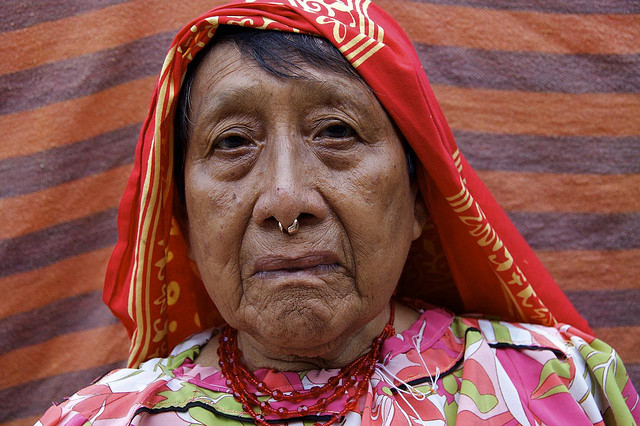
They sit, squinting, next to a pile of colorful homemade fabrics (molas) and beaded bracelets along well-traveled streets or in shaded parks. Unlike some vendors, these Kuna women let the loud colors of the handicrafts do the advertising and shyly smile when you pursue their selection.
Who are these women, with Harry-Potter-like tattoos running down their foreheads, pierced septums and ancient eyes? Lucky for me, on an island trip to San Blas, the Kuna invited me to partake in one of their most sacred traditions: the life celebration.
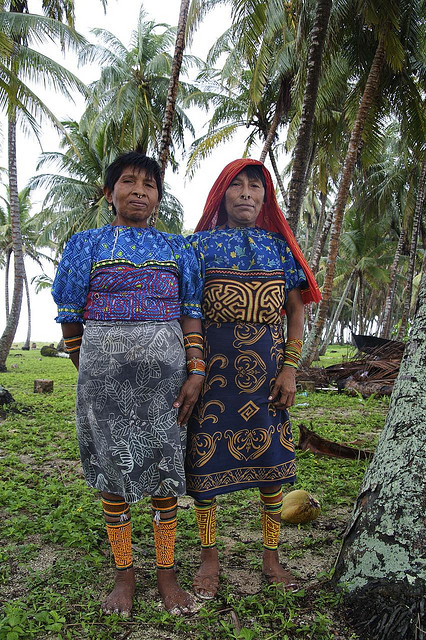
This typically happens approximately three times a year to welcome a girl to adulthood, and commonly her family provides the town with a day-long fiesta of free alcohol, cigarettes and bubble gum.
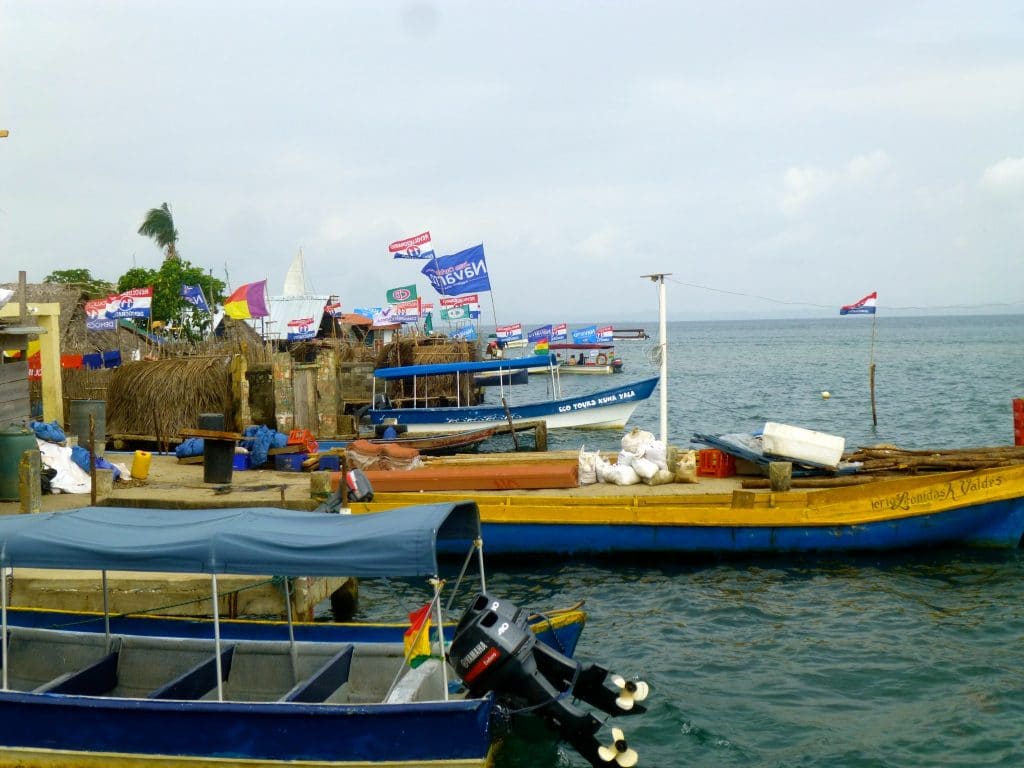
Kuna village, San Blas Islands, Panama. Photo courtesy of Katie Foote.
Arrival At Their San Blas Village, Kuna Yana, Panama
The boat pulls up to the Kuna village; however, it looks eerily abandoned, despite the festive election flags flying. As it is our third day on Central America‘s San Blas Islands we’re better at systematically disembarking the boat. This time, though, we look questioningly at the captain before hopping out. Brando, the grizzly guide who scored us the invitation, reassuringly gestures to have us follow him into the villages.
As we unload, Kuna kids in their underwear race to greet us, brown limbs flying, looking for high fives. Even on our “home” island the indigenous children appear everywhere, borrowing sun block to give each other tribal face paint, throwing coconuts or flinging each other off hammocks. But today, they roam exceptionally free, completely unsupervised. As we walk through the sandy streets, the already tipsy Kuna captain unsuccessfully tries to find a non-deserted store to snag a beer.
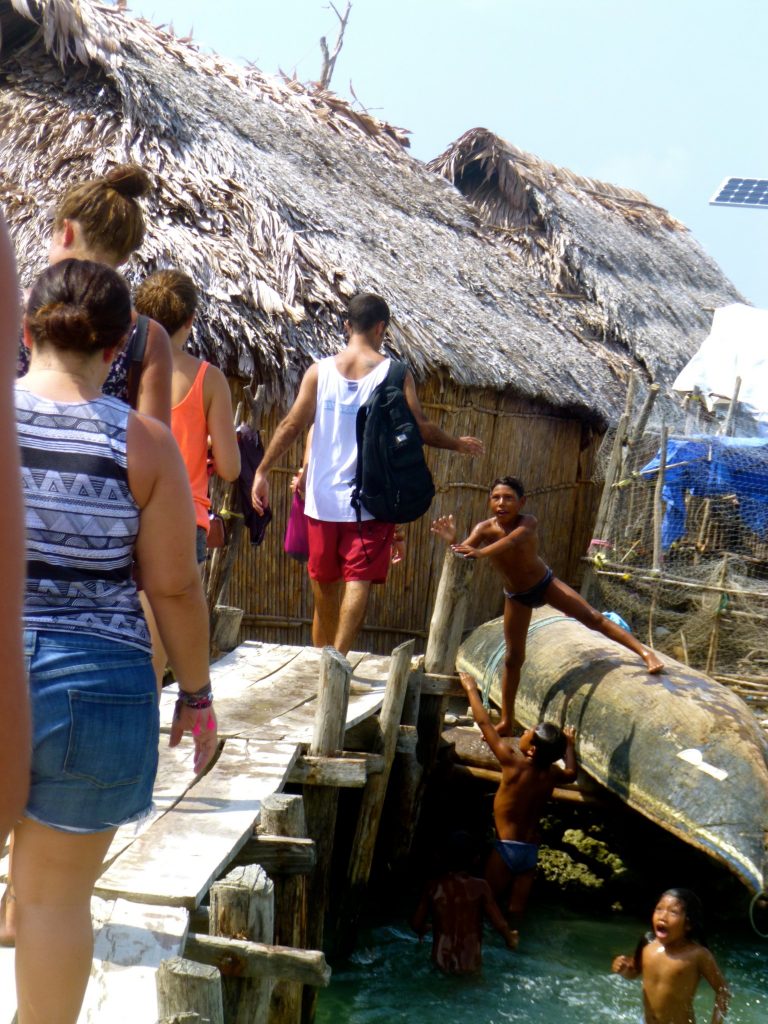
Kuna kids as we enter Kuna Yana, San Blas, Panama. Photo courtesy of Katie Foote.
Drinking Chicha From Coconuts
Consistent with his jungle hunter appearance, Brando — our island guide who has been living amongst the Kuna for three months– tilts his head, sniffs his nose and points us in the direction of the large Casa de Congreso.
The sounds of bachata grow louder as we tentatively approach the large thatched congress hut. We crouch to enter and blink as our eyes acclimate to the dusty darkness and the smoke billowing out from the low-entry opening.
We see horseshoe-shaped benches, men on one side and women on the other, organized by age. The teens take a peripheral position near the door, puffing their chests to look nonchalant, although their anxious grins give them away. In the center, a man in a cerulean collared shirt and a cowboy hops sideways, the string of animal bones broadcasting his movements.
Except for the women, everyone is dressed in decidedly un-ethnic garb. With the upcoming election, most men sport political propaganda, often advertising two political candidates with their trucker hats and T-shirts sending contradictory messages.
We plant ourselves on a bench and I watch four adjacent wrinkly men (one in a Yankees jersey, a “junior soccer league champs” tee, a knock-off Polo collared shirt and a Metallica tank) rise and head to the center when handed a coconut cup full of chicha, indigenous, fermented sugar cane and coffee. They click their coconuts, let out a chimp-y chant and start to do a dizzy-bat-esque dance around the center. They stop, line up, chug the liquid and, after dramatic brow wiping and spitting, they pass their coconuts to the next few.
Just as I acclimate to the rhythm of the ritual, bouncing my feet in time to the shaken animal bones, a short man enters the hut and everyone stops to stare. Loaded with lollipop-sized rings, his fingers hardly fit in the pockets of his black jeans. Gold chains encircle his neck, a cowboy hat with a dusty feather covers his silvery hair and his black-collared shirt praises “Music and Money”.
“Where’s the poker tournament?” jokes the Argentinean next to me as we watched the locals stand to honor this urban cowboy.
Eventually, someone passes me the coconut. It takes all my inner fortitude to finish my portion of the celebratory chicha. I force myself to swallow the charred taste of rotten olives and coffee grinds. The man who passed me the coconut looks at me expectantly, and I muster a spitball that I tentatively send to the ground. With an approving nod, he advances.
Shaded Story Time: History Of The Kuna
After an hour or so, woozy from the booze, heat and smoke, Brando decides to show us the village. We squeeze through skinny walkways, duck under breadfruit trees, walk by convenience stores with cardboard signs listing the available products and outhouses precariously placed over water. We sit on the shaded steps near the school’s basketball court and Brando shares what learned living alongside the Kuna.
We hear about their battle for independence and their current political system, the most advanced of any tribal group in Latin America. Three chiefs (including the “Music & Money” man) democratically manage village affairs, making communal decisions from the Congress Hut. They move families from island to island every three months to help preserve their culture and ensure that everyone can experience island life. Although the community pools their resources, Kuna have always placed a strong emphasis on economic success and international trade has earned them the financial stability.
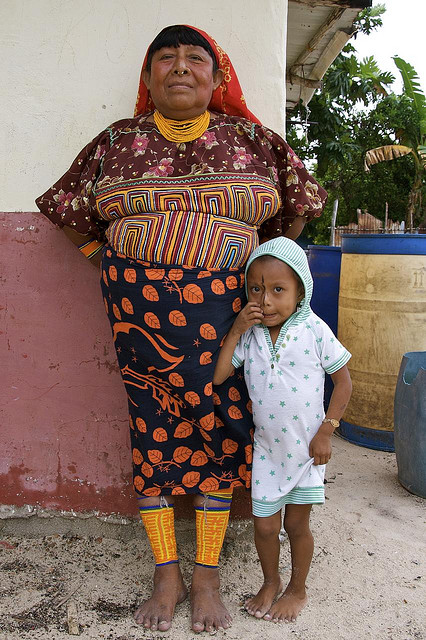
Kuna woman and child. Photo courtesy of Marc Veraart.
Fiesta Fever: Female Side Of The Tent
After learning a bit more about local traditions, we wander the town again when one of the women from our island recognizes us and drags the girls to the female entrance, the real party site. While entering, we bump by a woman in a santa hat who baptizes us with free-flying alcohol.
She waves around a bottle of rum, like the Pirates of the Caribbean at Disney World. The women take full advantage of the free tobacco, chain-smoking cigarettes and nuzzling each other’s foreheads as they bend down to share a light. They giggle and fall all over each other, snatching at the pipe that one lucky gal tries to puff.
Two gay men in skin-tight Western clothes also occupy this side, making everyone especially giddy with flamboyant dance moves. Us gringo girls accept our shot of rum, smiling at the upgrade from chicha, and our male friends give us stony stares, jealous our side has more fun.
After an afternoon of sharing, fellowship and celebration, we end an incredible day and head back to our island tents. The Kunas start the life celebration around 9 AM and will continue to party until 6 PM or until they drink all the chicha, followed by seco (a clear, seventy-proof regional liquor) and beer.
The Kuna believe drunkness during ceremonies like these are essential for obtaining salvation. One of their proverb counsels that if one fails to become completely intoxicated with chicha, he will not enter the house of God so the Kuna devote the whole day to trying. Once intoxicated, the drinking typically devolves into traditional dance.
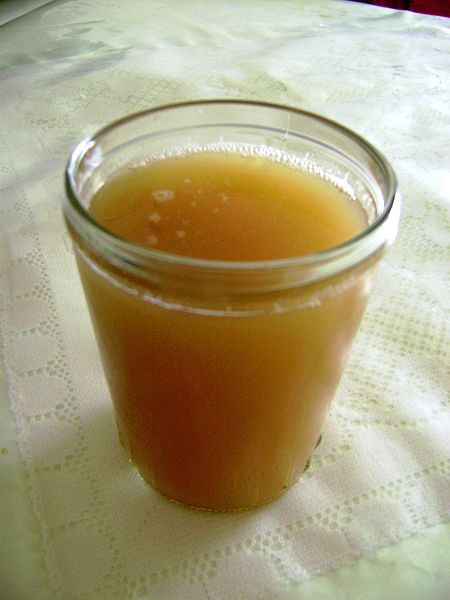
Chicha beer. Photo courtesy of Dtarazona.
Living Life To The Fullest
The Kuna don’t just know how to celebrate life- they know how to live it to the fullest. Although shy, their curiosity inspires them to reach out to people with different backgrounds. They generously allowed us to partake in one of their most sacred ceremonies.
Throughout the day, even tipsy members of the Kuna asked us about where we came from and wanted to share stories. Their open-minded attitude and intelligence shines through conversations and they seek out diverse perspectives. At the same time, they stand by their own cultural traditions and values. They work hard to maintain a distinctive identity and warmly share it with strangers. Their ceremony reinvigorated me to pursue life with an open mind and an open heart.
Top photo credit: Kuna women. Photo courtesy of Marc Veraart.

Jessica Festa is the editor of the travel sites Jessie on a Journey (http://jessieonajourney.com) and Epicure & Culture (http://epicureandculture.com). Along with blogging at We Blog The World, her byline has appeared in publications like Huffington Post, Gadling, Fodor’s, Travel + Escape, Matador, Viator, The Culture-Ist and many others. After getting her BA/MA in Communication from the State University of New York at Albany, she realized she wasn’t really to stop backpacking and made travel her full time job. Some of her most memorable experiences include studying abroad in Sydney, teaching English in Thailand, doing orphanage work in Ghana, hiking her way through South America and traveling solo through Europe. She has a passion for backpacking, adventure, hiking, wine and getting off the beaten path.








